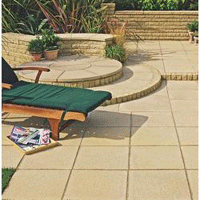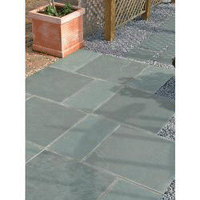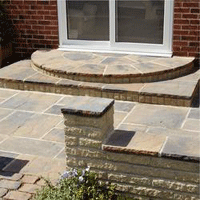Thinking about adding a patio to your garden? It’s a great way to enhance your outdoor space. Your patio can be as simple as a paved area outside your door, a Mediterranean-inspired outdoor retreat, or even a cozy dining spot tucked away at the end of your garden. The choice is really up to you!
How do you Plan a Patio Layout?
Planning a patio layout is an exciting step in creating the perfect outdoor space for your home, especially if you do it yourself, as you can then design it to be exactly what you want it to be.
Whether you’re dreaming of a sunny spot for relaxing or a functional area for entertaining, thoughtful planning will ensure your patio fits your needs and enhances your garden.
Here’s a brief summary of what you will need to think about, before we go into more details below.
- 1. How are you Going to use it?: Start by considering how you want to use your patio. Is it for dining, relaxing, or hosting parties? Or as a multifunctional space that can accommodate different uses? This step is key and will dictate the rest of the design process.
- 2. Choose the Best Location: The location of your patio is key, so think about sunlight and shade throughout the day and how you will use it. Proximity to the house is also important, especially for dining, as it makes carrying food and drinks more convenient. In smaller UK gardens, a patio at the far end can create a sense of depth and offer a peaceful retreat from the house.
- 3. Measure and Map Out Space: Accurate measurements are key. Use graph paper or an online garden design tool to map out the layout. Consider paths, furniture, and any existing features like trees, flower/veg beds etc. Also, make sure there’s enough space for movement and seating.
- 4. Select Your Materials: The materials you choose will impact the style and durability of your patio. Popular options in the UK include sandstone for a traditional look, consider porcelain for a modern touch, or block paving for added texture. Think about how the material will complement your garden and handle the UK’s weather conditions, especially creating slippery surfaces.
- 5. Factor in Drainage: Good drainage is vital for a long-lasting patio, especially with the volume of rain in the UK. Make sure your patio has a slight slope away from your home to prevent water pooling. Adding drainage channels or a soakaway which will further manage rainwater effectively.
- 6. Add the Finishing Touches: Once the layout is planned, think about the finishing details. Include lighting for evening use, planters for greenery, shelters etc. and what soft furnishings you will use. These extras will bring personality and make it an inviting and relaxing space.
What’s the Best Size for a Patio?
When it comes to the size of patio you should plan, again, this will really depend on the size of garden you have and what portion of it you are going to set aside for the patio, what you are going to use it for and also what you will feature on it.
If you build it too small then obviously it won’t be any good as you won’t be able to fit all your desired features on and it may not be big enough to actually stand on and use for more than a few people.
Similarly, if it’s too big, it may completely take over your garden and ruin it.
When planning and designing a patio for your home, consider the following points to make sure you get it the right size:
- Look at the Space Available: How big is your garden and how much do you want to a-lot to a patio. A good rule of thumb is allowing for about 20% of your total garden size
- What are you Using it for?: What will you use it for? Relaxing, dinning, events etc. How many people are you likely to want to sit if any tables or seating featured
- Flow and Movement: Leave enough space for any and everyone to move freely and easily without any stress
- Existing Styles: Your patio should complement your existing garden and should not under or overwhelm it!
- Future Plans: Consider how the patio may be used in the future e.g. larger gatherings, more furniture etc. Make sure any such things are considered
Where to Position Your Patio
Where you place your patio is of extreme importance as its location bears a heavy influence on how it’s used and how user friendly it is. Choose your patio’s location based on when and for what you’ll use it most.
For dinning, entertaining and evening meals outdoors, pick a spot that catches the evening sun. If you love soaking up the rays, go for a sunny area that stays bright all day.
Similarly, for dinning, entertaining and the likes, being near the house will minimises distance when transporting food and drinks and also allow guests easier access to facilities in the house.
However, while placing your patio near the back door might seem convenient, it may not be ideal if it’s shaded by the house.
If you prefer a cooler, more relaxing spot, opt for a shady area perfect for summer relaxation.
Prioritise shelter and privacy by using walls, screens, or tall plants to create a cozy and wind-protected space. This not only makes your patio more comfortable but also adds security for outdoor furniture and barbecues left outside.
To summarise what to think about in terms of positioning, think about the following:
- How will it be used?
- Where it looks best
- Where it will fit
- Shading issues
- How much privacy
- Is it too close/far to the house
- Are there any major obstructions
Are Zoned Patio’s a Good Idea?
Creating a zoned patio can be a fantastic way to make the most of your outdoor space, especially in UK gardens where maximising functionality and aesthetics is key.
So what exactly is a zoned patio? Well, this is a patio that’s designed with specific sections for different activities.
For example, you might have a dining area with a table and chairs, a lounge space with outdoor sofas, and a separate corner for a fire pit or barbecue.
These zones are often separated visually using different materials such as block screens, different levels, or decorative features like planters, bamboo screen and the similar.
When it comes to benefits, zoning your patio adds structure and functionality to your garden. It allows you to make better use of your space by tailoring each section to its purpose, so that you can cater for a variety of needs.
The best way to design such an area is to start by planning the layout based on your garden’s size and your needs. Use changes in materials, like paving for the dining area and decking for a lounge space, to visually separate zones.
Adding levels is another great way to divide the patio—for example, a raised area can serve as a seating nook. Include lighting and accessories like rugs or cushions to enhance the ambiance of each zone.

Patio constructed using sandstone slabs

Patio example constructed using slate slabs

Patio constructed using quarry slabs featuring a stepped area and wall
Are Shelters a Good Idea?
As with all things, it really does depend on what it’s going to be used for and what your own personal tastes are.
If your patio is going to be sited in quite an open, exposed area, then adding some form of shelter may be beneficial as it will provide cover for particularly hot and sunny days and also for less nicer days, can provide cover from the wind and rain.
In terms of options available, often with patios, the pergola is the go-to item to look at and although it doesn’t technically provide full cover, as the roof and sides are open, these can be added if required.
Available in a variety of materials (mostly metal and timber) and also a huge number of variations to suit both budget and taste, there is sure to be a solution that fits your requirements.

Standard timber pergola with covered timber roof
Materials and Patterns for a Patio
Choosing the right material to build with and pattern layout for your patio can be challenging, but it’s an important decision that shapes the final look and feel.
As I’m sure you can imagine there is a huge range of options available, so to kick off, start by considering your budget. While stunning Cornish slate may catch your eye, it’s essential to ensure that you won’t break the bank.
When it comes to materials, again, there is a huge range to choose from. Starting at the cheaper end of the scale comes standard concrete slabs, however if budgets allow, stone-effect concrete, natural stone like slate, York stone, or reclaimed flagstones, and even cobbles are a great choice.
Bricks or pavers are also a great choice, offering warm tones and stylish patterns like basket weave or herringbone.
For inspiration, visit local reclamation yards for unique reclaimed stone options, which often add character and charm. Many also stock new slabs if you’re looking for something fresh and consistent.
When selecting a colour, think about contrast and practicality. A darker stone may complement pale walls and create a warmer, heat-retaining effect, while lighter slabs can brighten shaded areas but may glare in direct sunlight.
Match your material to your home’s style. A modern house pairs well with sleek concrete, while reclaimed stone suits a traditional property.
By balancing aesthetics, budget, and surroundings, you’ll create a patio that enhances your garden’s character and feels perfectly at home.
Features for a Patio Area
Adding a focal point to your patio can make it more inviting and visually appealing. This could be a feature like a pattern in the paving or an eye-catching addition.
Fire pits are a popular choice and can be seamlessly built into your patio. Alternatively, a corner filled with vibrant potted plants adds colour and charm. For a unique touch, leave a few slabs out and replace them with fragrant herbs or colourful flowers.
Consider functional features like a brick or stone seating area integrated into the patio or a built-in brick barbecue for outdoor entertaining. Water features, such as a bubbling fountain or a raised pond with wide edges that double as seating, can add a tranquil vibe.
Don’t forget lighting to enhance your patio’s atmosphere. If it’s near the house, installing an outdoor light is straightforward. For patios further away, solar lights or oil lanterns are excellent alternatives to create a cozy glow as evening falls.
In recent years, patio heaters have emerged on to the market. These are very handy tools and can provide a decent amount of heat to your patio area, when entertaining on colder evenings. Available in a range of sizes and styles, you are sure to find something that suits your needs.
With your patio design finalised, you can proceed to laying the patio and bringing your vision to life.
So, as a summary of pointers to think about in terms of features, here are some of the most poignant ones:
- Fire pits
- Seating features – Brick or stone-built
- Plants and greenery
- Brick-built BBQ’s
- Water features
- Mood lighting
- Heating
Likely Costs of a Patio Build
Building a patio can transform your outdoor space, but understanding the costs involved is essential to budget effectively and ensure you have the funds to complete your project. Patio costs in the UK vary widely, depending on factors like materials, size, location and whether you choose to hire a professional or take a DIY approach.
The most likely areas to look at and some rough estimates to give you an idea are as follows:
1. Material Costs
The choice of materials has one of the largest impacts on overall cost. Basic concrete slabs are the most affordable option, starting at around £10–£15 per square metre.
Mid-range materials like stone-effect concrete or natural sandstone slabs typically cost £20–£50 per square metre, where premium materials, such as slate or York stone, can range from £50–£100+ per square metre.
Reclaimed materials, like flagstones or cobblestones, are also available but may vary in price based on availability and quality.
2. Labour Costs
If you hire a professional, labour costs in the UK typically range between £75 and £150 per day.
For a standard 20 square metre patio, labour charges may fall between £1,000 and £2,500, depending on complexity, access to the site, and regional variations. Professionals often provide a package price that includes materials, so it’s worth comparing quotes.
3. Additional Features and Finishing
Incorporating features like built-in seating, fire pits, or decorative edging will again add to the total cost.
For example, a built-in fire pit can cost an additional £500–£1,000, while lighting or water features might add £100–£500 depending on the type and installation method.
To help the longevity of your patio area, adding a protective sealant to its surface can cost around £2–£4 per square metre but will help prolong its life.
4. DIY vs. Professional Installation
Opting for a DIY build can save money, but you’ll need to account for the cost of tools that you may not have, such as spades, mixers, and levelling equipment, which can add £100–£500 to your expenses.
While DIY projects might reduce labour costs, they require time, effort, and a degree of expertise to ensure a durable and professional finish.
5. Overall Budget Considerations
For a basic patio with affordable materials, expect costs to start at around £500–£1,000 for DIY and £1,500–£2,500 for professional installation.
Larger or premium patios with intricate designs and added features can range pretty greatly, from £3,000–£10,000 or even more!
To avoid unexpected expenses, always get multiple quotes, factor in potential extra costs like waste disposal, and always, always allow for and additional 10–20% on top of your budget.
Building a patio in your garden is a fantastic way of getting everyone outside to enjoy the fresh air and nature, and if you have a basic, grounded understanding of DIY and construction, then it’s certainly within anyone’s means to construct one to a professional standard.

